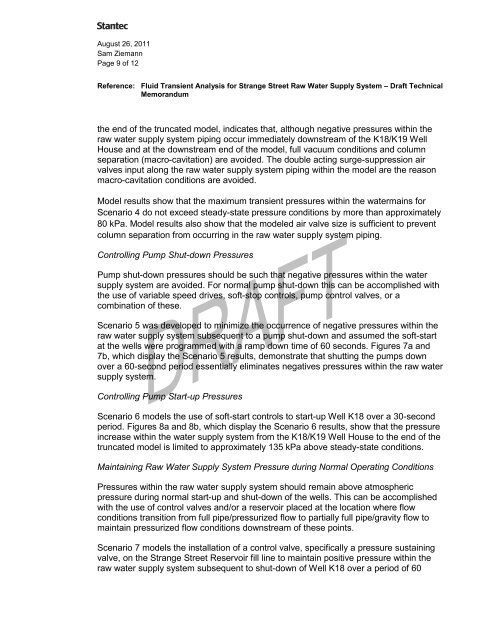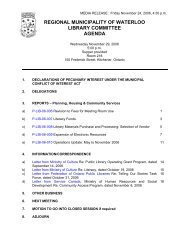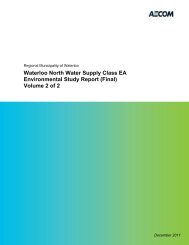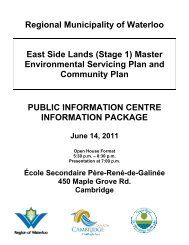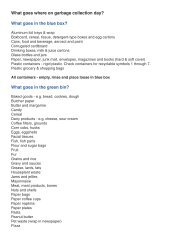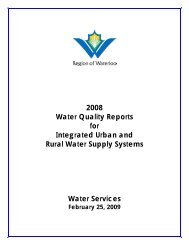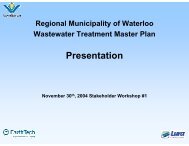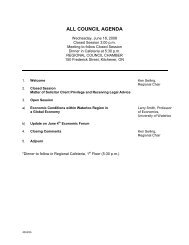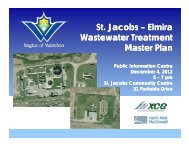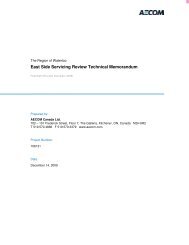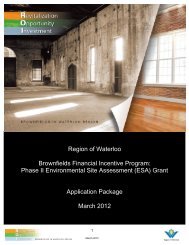Sam Ziemann From - Region of Waterloo
Sam Ziemann From - Region of Waterloo
Sam Ziemann From - Region of Waterloo
Create successful ePaper yourself
Turn your PDF publications into a flip-book with our unique Google optimized e-Paper software.
August 26, 2011<strong>Sam</strong> <strong>Ziemann</strong>Page 9 <strong>of</strong> 12Reference: Fluid Transient Analysis for Strange Street Raw Water Supply System – Draft TechnicalMemorandumthe end <strong>of</strong> the truncated model, indicates that, although negative pressures within theraw water supply system piping occur immediately downstream <strong>of</strong> the K18/K19 WellHouse and at the downstream end <strong>of</strong> the model, full vacuum conditions and columnseparation (macro-cavitation) are avoided. The double acting surge-suppression airvalves input along the raw water supply system piping within the model are the reasonmacro-cavitation conditions are avoided.Model results show that the maximum transient pressures within the watermains forScenario 4 do not exceed steady-state pressure conditions by more than approximately80 kPa. Model results also show that the modeled air valve size is sufficient to preventcolumn separation from occurring in the raw water supply system piping.Controlling Pump Shut-down PressuresPump shut-down pressures should be such that negative pressures within the watersupply system are avoided. For normal pump shut-down this can be accomplished withthe use <strong>of</strong> variable speed drives, s<strong>of</strong>t-stop controls, pump control valves, or acombination <strong>of</strong> these.Scenario 5 was developed to minimize the occurrence <strong>of</strong> negative pressures within theraw water supply system subsequent to a pump shut-down and assumed the s<strong>of</strong>t-startat the wells were programmed with a ramp down time <strong>of</strong> 60 seconds. Figures 7a and7b, which display the Scenario 5 results, demonstrate that shutting the pumps downover a 60-second period essentially eliminates negatives pressures within the raw watersupply system.Controlling Pump Start-up PressuresScenario 6 models the use <strong>of</strong> s<strong>of</strong>t-start controls to start-up Well K18 over a 30-secondperiod. Figures 8a and 8b, which display the Scenario 6 results, show that the pressureincrease within the water supply system from the K18/K19 Well House to the end <strong>of</strong> thetruncated model is limited to approximately 135 kPa above steady-state conditions.Maintaining Raw Water Supply System Pressure during Normal Operating ConditionsPressures within the raw water supply system should remain above atmosphericpressure during normal start-up and shut-down <strong>of</strong> the wells. This can be accomplishedwith the use <strong>of</strong> control valves and/or a reservoir placed at the location where flowconditions transition from full pipe/pressurized flow to partially full pipe/gravity flow tomaintain pressurized flow conditions downstream <strong>of</strong> these points.Scenario 7 models the installation <strong>of</strong> a control valve, specifically a pressure sustainingvalve, on the Strange Street Reservoir fill line to maintain positive pressure within theraw water supply system subsequent to shut-down <strong>of</strong> Well K18 over a period <strong>of</strong> 60


